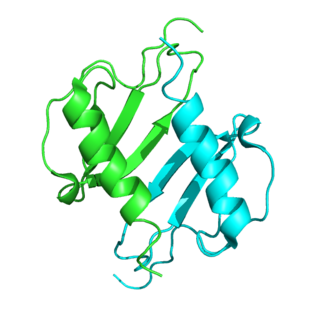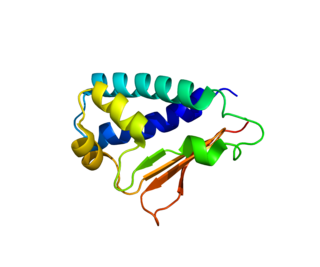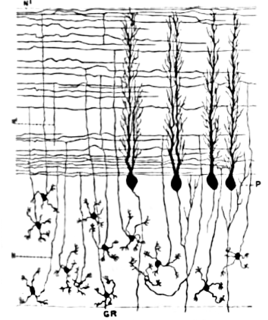
The stromal cell-derived factor 1 (SDF1), also known as C-X-C motif chemokine 12 (CXCL12), is a chemokine protein that in humans is encoded by the CXCL12 gene on chromosome 10. It is ubiquitously expressed in many tissues and cell types. Stromal cell-derived factors 1-alpha and 1-beta are small cytokines that belong to the chemokine family, members of which activate leukocytes and are often induced by proinflammatory stimuli such as lipopolysaccharide, TNF, or IL1. The chemokines are characterized by the presence of 4 conserved cysteines that form 2 disulfide bonds. They can be classified into 2 subfamilies. In the CC subfamily, the cysteine residues are adjacent to each other. In the CXC subfamily, they are separated by an intervening amino acid. The SDF1 proteins belong to the latter group. CXCL12 signaling has been observed in several cancers. The CXCL12 gene also contains one of 27 SNPs associated with increased risk of coronary artery disease.

Chemokines, or chemotactic cytokines, are a family of small cytokines or signaling proteins secreted by cells that induce directional movement of leukocytes, as well as other cell types, including endothelial and epithelial cells. In addition to playing a major role in the activation of host immune responses, chemokines are important for biological processes, including morphogenesis and wound healing, as well as in the pathogenesis of diseases like cancers.

C-X-C chemokine receptor type 4 (CXCR-4) also known as fusin or CD184 is a protein that in humans is encoded by the CXCR4 gene. The protein is a CXC chemokine receptor.

Interleukin 8 is a chemokine produced by macrophages and other cell types such as epithelial cells, airway smooth muscle cells and endothelial cells. Endothelial cells store IL-8 in their storage vesicles, the Weibel-Palade bodies. In humans, the interleukin-8 protein is encoded by the CXCL8 gene. IL-8 is initially produced as a precursor peptide of 99 amino acids which then undergoes cleavage to create several active IL-8 isoforms. In culture, a 72 amino acid peptide is the major form secreted by macrophages.

For the ICAO airport code see Candle Lake Airpark, for the diradical compound see Dichlorocarbene.

Medulloblastoma is a common type of primary brain cancer in children. It originates in the part of the brain that is towards the back and the bottom, on the floor of the skull, in the cerebellum, or posterior fossa.

C-X-C motif chemokine ligand 10 (CXCL10) also known as Interferon gamma-induced protein 10 (IP-10) or small-inducible cytokine B10 is an 8.7 kDa protein that in humans is encoded by the CXCL10 gene. C-X-C motif chemokine 10 is a small cytokine belonging to the CXC chemokine family.

C-X-C motif chemokine 11 (CXCL11) is a protein that in humans is encoded by the CXCL11 gene.

The chemokine ligand 1 (CXCL1) is a small peptide belonging to the CXC chemokine family that acts as a chemoattractant for several immune cells, especially neutrophils or other non-hematopoietic cells to the site of injury or infection and plays an important role in regulation of immune and inflammatory responses. It was previously called GRO1 oncogene, GROα, neutrophil-activating protein 3 (NAP-3) and melanoma growth stimulating activity, alpha (MGSA-α). It's also known as keratinocytes-derived chemokine (KC) in mice or cytokine-induced neutrophil chemoattractant type-1 (CINC-1) in rats. In humans, this protein is encoded by the gene Cxcl1 and is located on human chromosome 4 among genes for other CXC chemokines.

Chemokine ligand 2 (CXCL2) is a small cytokine belonging to the CXC chemokine family that is also called macrophage inflammatory protein 2-alpha (MIP2-alpha), Growth-regulated protein beta (Gro-beta) and Gro oncogene-2 (Gro-2). CXCL2 is 90% identical in amino acid sequence as a related chemokine, CXCL1. This chemokine is secreted by monocytes and macrophages and is chemotactic for polymorphonuclear leukocytes and hematopoietic stem cells. The gene for CXCL2 is located on human chromosome 4 in a cluster of other CXC chemokines. CXCL2 mobilizes cells by interacting with a cell surface chemokine receptor called CXCR2.

C-X-C motif chemokine 5 is a protein that in humans is encoded by the CXCL5 gene.
Chemokine ligand 14 (CXCL14) is a small cytokine belonging to the CXC chemokine family that is also known as BRAK. Mature CXCL14 has many of the conserved features of the CXC chemokine subfamily but has some differences too, such as a shorter N-terminus and five extra amino acids in the region between its third and fourth cysteines. CXCL14 is constitutively expressed at high levels in many normal tissues, where its cellular source is thought to be fibroblasts. However, it is reduced or absent from most cancer cells. This chemokine is chemotactic for monocytes and can activate these cells in the presence of an inflammatory mediator called prostaglandin-E2 (PGE2). It is also a potent chemoattractant and activator of dendritic cells, is implicated in homing of these cells, and can stimulate the migration of activated NK cells. CXCL14 also inhibits angiogenesis, possibly as a result of its ability to block endothelial cell chemotaxis. The gene for CXCL14 contains four exons and is located on chromosome 5 in humans.
CXC chemokine receptors are integral membrane proteins that specifically bind and respond to cytokines of the CXC chemokine family. They represent one subfamily of chemokine receptors, a large family of G protein-linked receptors that are known as seven transmembrane (7-TM) proteins, since they span the cell membrane seven times. There are currently six known CXC chemokine receptors in mammals, named CXCR1 through CXCR6.

Chemokine ligand 7 (CXCL7) is a human gene.
Chemokine ligand 17 (CXCL17) is a small cytokine belonging to the CXC chemokine family that has been identified in humans and mice. CXCL17 attracts dendritic cells and monocytes and is regulated in tumors. It is also known as VEGF co-regulated chemokine 1 (VCC-1) and dendritic cell- and monocyte-attracting chemokine-like protein (DMC). This chemokine is constitutively expressed in the lung. The gene for human CXCL17 is located on chromosome 19.

Interleukin 8 receptor, beta is a chemokine receptor. IL8RB is also known as CXCR2, and CXCR2 is now the IUPHAR Committee on Receptor Nomenclature and Drug classification-recommended name.

Interleukin 8 receptor, alpha is a chemokine receptor. This name and the corresponding gene symbol IL8RA have been replaced by the HGNC approved name C-X-C motif chemokine receptor 1 and the approved symbol CXCR1. It has also been designated as CD181. The IUPHAR Committee on Receptor Nomenclature and Drug Classification use the HGNC recommended name, CXCR1.

Protein BTG2 also known as BTG family member 2 or NGF-inducible anti-proliferative protein PC3 or NGF-inducible protein TIS21, is a protein that in humans is encoded by the BTG2 gene and in other mammals by the homologous Btg2 gene. This protein controls cell cycle progression and proneural genes expression by acting as a transcription coregulator that enhances or inhibits the activity of transcription factors.

Protein BTG1 is a protein that in humans is encoded by the BTG1 gene.

Cerebellar granule cells form the thick granular layer of the cerebellar cortex and are among the smallest neurons in the brain. Cerebellar granule cells are also the most numerous neurons in the brain: in humans, estimates of their total number average around 50 billion, which means that they constitute about 3/4 of the brain's neurons.



















